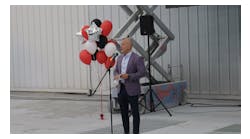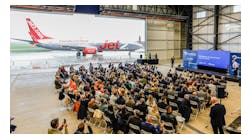Every aviation-related organization, from an airport to a charter management company to a flight department to an OEM to an MRO (and everything in between), has a customer service culture. The unique customer service culture of any organization is described by a combination of characteristics. Certain characteristics align with one of four customer service culture profiles. Ultimately, our organization’s total customer service culture is a combination of all four profiles, though usually one cultural profile is more dominant than the others. The concept of customer service culture can be applied to an entire company, to a location or to individual departments within that location.
Over the years, Gene has been a part of or worked with many different organizations within aviation: charter management companies, corporate flight departments, flight planning organizations, and airports. Gene’s breadth of experience has given him exposure to many different cultures within aviation, but there seem to be consistent patterns in the culture of competitive companies. Gene’s observations are captured below, in the explanation of the parameters that define a true service culture.
Technical Skills and Relationship Skills
First, both technical skills and what we might call “relationship” skills are part of every excellent organization’s service culture. Twenty years ago, a mechanic, line services employee, or pilot might have thought that as long as they possessed the technical skill to do their jobs, then they were assured of a job. Today, that is no longer enough. Customers (and employers) do expect that a trained professional has excellent technical skills; but they also expect effective, friendly communications — what is referred to as ‘relationship skills’.
Second, competitive aviation companies understand that the culture of service delivery happens both outside and inside the organization. Many of us instinctively understand that we must apply technical and relationship skills during the delivery of service to our paying customers, but outstanding companies understand that those same skills are needed when delivering services within its own organization (to team members). Thus, the second dimension of a service culture directly speaks to the effectiveness of service delivery to external and internal customers.
Technical and relationship skills must be applied to both internal and external customers. When these skills are related to our organization’s (or location’s or department’s) internal and external service delivery, we can assess it by looking at the culture on the Service Culture Quadrant (SEE DIAGRAM).
The first customer service culture profile is called the Insider’s culture. The Insider’s culture pays attention to internal customers and the relationships between and among them. In a word, the Insider’s culture is about teamwork. The second profile is called the Technical culture, which relies on the technical capabilities of employees. Aviation-related companies often have strong technical cultures, because employees have high levels of technical knowledge, skill, or ability and rely on that for organizational survival. On the other hand, the third profile, which is Market culture, relies on assessing the external customers’ needs and mobilizes or finds the technical capabilities necessary to meet those needs. The fourth and final quadrant is the Customer culture that is sensitive to relationships and communications with the external customer. An organization that ranks high in this quadrant believes in and works hard for the relationship with the external customer.
The Four Quadrants
Insider's Culture
The first customer service culture profile is called the Insider’s culture. The Insider’s culture pays attention to internal customers and the relationships between and among them. But what exactly does this mean?
An organization that pays attention to the relationships between and among internal customers is basically interested in making sure that the people who work within that company (the employees) have productive, positive relationships. The description of an MRO that is a ServiceElements’ client will be helpful in describing the Insider’s culture. (The name of the MRO will be changed so as not to put the organization on the spot, even though the example is complimentary). Employees at “Best MRO” regularly receive training in areas related to conflict, communication, teamwork, and customer service. Leadership/management at BEST MRO regularly asks employees for suggestions on operations, and whether there is anything that management can do to improve the MRO’s service and work environment. Problems do crop up at BEST MRO, especially between departments, but employees have learned that miscommunication is part of every organization. The key for every BEST MRO employee is not to take miscommunications and disagreements personally but to focus on the larger goal of creating a positive workplace, which is something everyone can agree upon.
BEST MRO is not a perfect organization, but the employees work to communicate with each other and to resolve conflict. Management has been proactive in its communications with employees and across departments. All of these are goals worth working toward, and all define a strong Insider’s culture. A strong Insider’s culture does not mean the absence of problems; it simply means that people work together to solve them.
Technical Culture
Technical proficiency within an organization has to do with the knowledge, skills, and abilities (KSA) of those who work within that organization. Do they have the requisite KSA to execute, technically, on delivering the product or service that the organization promises to provide to its customers? If so, then the Technical culture within the organization is likely strong, provided that two other elements exist: training and effective standard operating procedures (SOPs). Training is critical so that everyone, from line services to customer service representatives, can grow their expertise and keep up with current developments in the field. Effective standard operating procedures are developed by expert people and ensure efficiency and consistency.
Within the aviation industry, there is a natural tendency for employees and managers to rely on their real and perceived technical capabilities for organizational, departmental, or group survival. This “reliance” on technical expertise is related to the history of aviation, which is very much associated with technological advancement and the highly skilled individuals who work with that technology. Maintenance technicians fix massive, intricate engines and instrument panels that enable flight. Pilots fly impressive airplanes with complicated instrumentation to measure speed and distance. The technical expertise that created the aviation industry continues to influence every organization associated with it, whether that be an FBO, an MRO, an airport, or an OEM. The perception that technical expertise built the industry and will carry it into the future is the dominant theme — even today. If we look, for example, where most organizations in the industry spend their training dollars, it is in the area of technical training.
Indeed, a strong Technical culture is a prerequisite for success in the aviation industry. Even for those who support the industry but do not fly planes or fix them — flight planners, line services, customer service representatives — there is an expectation that they carry a greater understanding and appreciation for the technical complexities which make flight possible. Despite all of this, while Technical culture is a necessary component to success, alone it is not sufficient — even within aviation. A disproportionate emphasis on the Technical culture means that a department or organization is too inwardly focused.
Market Culture
The Market culture contrasts with the Technical culture in one main respect: it is outwardly focused on the customer and external constituents rather than inwardly focused on the talents of the people within the organization. The KSA of individuals within the organization are used as a tool to respond to what the customers want or to shape their perceptions. Naturally, then, Market culture driven customer service organizations are also very responsive to customer inputs and perceptions, particularly as they pertain to the technical aspects of whatever product or service is offered. Thus, issues related to design and delivery become central. Market driven service cultures have mechanisms in place to gather this feedback or track it, and they deploy the necessary resources to address any problems, concerns, issues, or needs. Market driven cultures are innovative, as they strive to provide new services or product features to gain that competitive edge.
Another feature of the Market culture that is very relevant to the aviation industry is the focus on numbers and the bottom line. Managers and leaders of Market driven cultures are very results oriented, and they are sometimes obsessed with numerical results that measure everything from profitability to customer service ratings. Consider the various industry ratings that appear in magazines and online. These lists of “the best” are not only a lightening rod of controversy and discussion, but they become a goal toward which aviation companies strive. It is not uncommon for Market-driven managers to do everything in their power to move their organizations up the list in such publications. The winners on these lists proudly advertise their placement on marketing collateral and website banners, because it is an indication of beating the competition. The popularity of such lists is a testament to the power of the market to shape organizational action.
In the end, every company within the aviation industry should pay heed to the market. However, obsession with the market may skew management action and wreak havoc on employee morale. We must remember that industry lists and quarterly profitability statements are short-term indicators of market success, but these indicators are susceptible to manipulation and fleeting customer attitudes and perceptions. Thus, like every other culture we have profiled, there are characteristics of the Market culture that we must nurture within our organizations, but those characteristics must not be the sole focus of our attention.
Customer Culture
The Market culture and Customer culture are both focused on the external customer, but the difference lies in the nature of that focus. The Market culture seeks to discern technical wants and needs of the customer; the Customer culture seeks to understand the feelings and perceptions of customers through effective interpersonal communications. Perhaps there is a relationship between the two, but there are important differences, from a customer service standpoint. Consider the powerful truth of the following point: it is not whether you solve a customer’s problem in exactly the way they want it to be solved (technical solution); what is important is that the customer feels like you are doing all you can to address their problems and that you are sensitive to their situation (relationship oriented solution).
Consider a customer who is angry because his aircraft maintenance is not finished on the promised date. The customer demands that the maintenance be completed immediately. Now, this demand may be impossible to meet. From a Market culture perspective, if we are not able to solve the problem immediately, we have, technically, failed to meet the customer’s need. The Market culture would predict that our failure to finish the maintenance immediately will soon be reflected in lower customer ratings and profitability. Luckily, a good dose of Customer culture will almost guarantee that ratings or profitability will not plummet. In fact, if we play our cards right, the result may be quite the opposite. The Customer culture recognizes that we may “smooth” situations if we address the relationship side of customer interactions. Research on customer service shows that we can win the customer and actually increase satisfaction and loyalty even if we do not solve the problem immediately — as long as the customer feels like we are a) listening to his complaints and concerns empathetically, and b) making every effort to provide alternatives and possibly compensation in other areas. This example points out how important it is to make sure every employee is trained in the finer skills of communications, relationships, and human behavior. For these are the areas that define the effectiveness with which an organization deploys the power of the Customer culture.
At the end of the day, customers make their judgments based on feelings and emotions that are shaped by the organization’s efforts to build relationships with them. Technical results are important, but every successful professional knows that bottom line results are, in the long-run, dependent on the quality of relationships that one is able to build with customers. That is the power of the Customer culture.
A Balanced Service Culture
In this article, we have established that every organization has a customer service culture. There are four service culture profiles that we covered: Insider’s culture, Technical culture, Market culture, and Customer’s culture. Every department or organization in every industry has a unique service culture that is a blend of each of these profiles. In most organizations, one profile may be more prominent than the others. The key to a successful operation and happy customers is finding a balance among all four cultural profiles. Aviation-related organizations tend to stress the Technical culture, which depends on the technical knowledge, skills, and abilities of their employees. But such an emphasis often overlooks the relational aspect between people (inside and outside the organization) that so often differentiates excellent companies from simply average ones.
Truly excellent organizations consciously seek to understand themselves — and the service culture profiles are an effective way to gain that understanding. With this understanding comes an honest assessment of cultural strengths and weaknesses, which in turn leads to purposeful improvements that create lasting competitive advantage.
Christine Jill is executive vice president of ServiceElements, a Phoenix-based firm specializing in people-development and customer service training for aviation professionals. For more information visit www.serviceelements.com.




